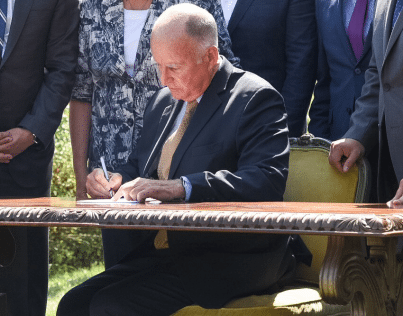
California Constitution. (Photo: www.sos.ca.gov)
Amending or Revising the California Constitution
It is one of the longest constitutions in the world
By Chris Micheli, October 18, 2019 6:01 am
The Constitution of the State of California, originally adopted in 1849, sets forth the powers, duties and functions of California state government. It is one of the longest constitutions in the world at over 100 pages in length, which is partly due to the number of voter-approved additions to the state constitution. The document can be amended by initiative passed by voters and these initiatives can be placed on the statewide ballot by legislators or voters.
An amendment to the State Constitution requires passage of a state ballot measure approved by a majority vote of the state’s electorate. These ballot propositions can be proposed by legislators or voters. For voters to place an amendment on the ballot, they must obtain signatures from voters that are equal to 8% of the votes cast in the last gubernatorial election, which is actually one of the lowest threshold of any state in the nation. Section 3 of Article 18 provides that the electors may amend the constitution by initiative.
The California Constitution may also be amended or revised by the State Legislature, as well as by the electorate. While the voters can approve a constitutional initiative on the statewide ballot, the Legislature can place a constitutional amendment on the Constitution. This process is allowed pursuant to Article XVIII of the State Constitution, which provides specific rules for amending and revising the California Constitution.
Section 1 of Article 18 provides the Legislature by rollcall vote entered in the Daily Journal, two-thirds of the membership of each house concurring, may propose an amendment to or revision of the Constitution. The Legislature can also, in the same manner, amend or withdraw its proposal.
Each amendment is prepared and submitted to the voters so that it can be voted on separately. The Governor does not act upon a proposed constitutional amendment. Once passed by a super-majority of both houses of the Legislature, the measure is placed on the next statewide ballot for a vote by the electorate.
Section 2 of Article 18 provides the Legislature by rollcall vote entered in the Daily Journal, two-thirds of the membership of each house concurring, may submit at a general election the question whether to call a convention to revise the Constitution. If the majority of the electorate votes yes on that question, within 6 months the Legislature must provide for the convention. Delegates to a constitutional convention are voters elected from districts as nearly equal in population as may be practicable.
Section 4 of Article 18 provides that a proposed amendment or revision must be submitted to the electors and, if approved by a majority of votes, takes effect the day after the election unless the measure provides otherwise. If provisions of two or more measures approved at the same election conflict with each other, then those of the measure receiving the highest affirmative vote prevails.
Although California’s initiative process has been criticized for being “too easy” to place a measure on the ballot for the people to adopt, it is important for both voters and the Legislature to have the power to amend or revise the state constitution. Although the electorate must always have the option to place a measure on the ballot, so too should the Legislature to ensure that potential amendments or revisions to the California Constitution get appropriate consideration by the lawmaking body for the State.
- Intercountry Adoptions - January 11, 2026
- The Uniform Foreign-Money Claims Act - January 10, 2026
- General Provisions of California’s LLC Act - January 10, 2026





Q; If there is a petition currently (Sept 2019) circulating w/ a deadline of Feb 2020, and an SCA directly related to said petition is passed by the legislation in Dec 2019, 1) when is the effective date of the amendment, 2) would it be retroactively applied to the terms and processes of the petition since the petition is not yet submitted to the county and state for verification?